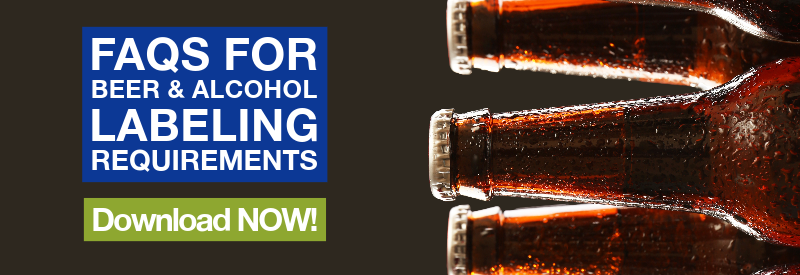
4 Reasons You Should Be Using Pressure Sensitive Labels
You may be wondering, what are pressure sensitive labels?
They just so happen to be the most popular type of product labeling on the market today, and their popularity is continuing to grow.
Why?
These types of labels work on any smooth, solid surface, whether it’s the side of a box, the neck of a bottle, or the top of a recessed lid. The label application process is simple. The label materials can be customized to fit almost any use, from adding shipping addresses to providing legible information after long term storage.
Now that you know the basics of what pressure sensitive labels are, you may be wondering what advantages these types of labels have over other product label options, and why you should use them.
1. Versatility and Scalability to Fit Your Business
Some labeling systems, like shrink sleeves, don’t make financial sense unless you’re dealing with massive product volumes.
However, with pressure sensitive label machines, almost any business will see cost benefits when the label printing and application process doesn’t require a worker to do them. Sometimes, the return on investment is even faster, thanks to increased product labeling accuracy, decreased product damage, and reduced floor space requirements. As your business grows, your equipment can keep up, handling thousands of inches of label printing each minute.
Our high-speed machines are designed to store label application calibration information, making it easy to switch between containers. That means you can cover a variety of similar-shaped product surfaces with one machine.
For example, our wine bottle labeler accommodates all common bottle sizes, and it can switch between wrap, cover and front and back labels with the right accessories. You can’t get that versatility from a cut-and-stack labeling system. To make calibration even easier, our updated 360a Model Y labeler is “self teaching,” making small adjustments on the fly for high-quality accuracy.
Choosing pressure sensitive labels also opens up more choices for containers. For example, we’ve seen a boom in aluminum can-use in the craft beer and soda industry, thanks to these types of labels. Instead of ordering custom label cans to be printed by the truckload, you can buy blank cans by the pallet, adding different embellishments to fit your different product lines. This keeps container inventory manageable, while letting you take advantage of aluminum’s sustainability and lower weight. In turn, this reduces product damage and shipping costs.
2. There are Pressure Sensitive Labels to Fit Almost Any Application
Pressure sensitive labels are made from several layers of material, including types of adhesives, face stock, inks, varnishes and top coatings. By changing these components, you can get a label that will work for almost any product. Because pressure sensitive labels use a variety of different adhesives, they can adhere to a variety of different substrates, or surfaces.
Selling frozen foods? You can get types of adhesives that’s solvents can withstand the extreme temperatures, and face stock material that resists moisture. Want to add lot numbers, expiration dates and other information to each container? Choose a thermal paper face stock, or one that absorbs ink. Our print-and-apply machines can add the text and graphics you need for each container.
This versatility doesn’t just cover practical product label concerns. The flexibility of pressure sensitive label design also gives you more options for custom label design. Want to highlight what’s inside your container? Plastic laminates like BOPP are available in transparent versions. Thanks to the different adhesives that pressure sensitive labels use, there’s also removable product labels available.
Looking for a way to make your labels pop on retail shelves? Foils, inks and coatings let you change the color of the product label, as well as how it reflects light and how it feels. There’s also a new trend toward ornate label shapes, which can be achieved by die cutting labels. In fact, every recent label design trend including embossing can be addressed using pressure sensitive labels.
3. Support, Supplies and Equipment is Readily Available
Thanks to the popularity of pressure sensitive labels, you’re spoiled for choice when it comes to suppliers. There’s a good chance there are several printers close to your facility that can provide you with the rolls you need for your machines.
Need a new label design? Your supplier may have label experts that can work with you, or you can find an outside designer who is familiar with the options available for these types of labels.
Lead times are far shorter than in-mold or shrink sleeve labeling, making it easy to change designs. This makes it practical to switch to custom labels for holiday sales or contests, or add new, low volume product lines. This is especially important for proofs. Even the best digital label proof can’t replicate the appearance of the label, so it’s important to get samples in hand as soon as possible.
Our high-quality specialty labeling machines are based on standard units like the 360a and 3600a, so components are always available. Many components are sourced from popular manufacturers. For example, our print-and-apply labelers use label printing engines from industry leaders like Sato and Zebra. This means new ribbons, print heads and other components are readily available. We also have a national network of distributors who will work with you to find the right label printing setup for your production system, and provide support for repairs and changes as needed.
4. A Labeling Solution That Fits Your Budget
This labeling solution offers self-adhesive labels, which simplifies the labeling application process. The labeler just peels the label and pushes it onto the container like a sticker, using sensors, arms and rollers to ensure accuracy. There’s no need for you to apply adhesive or heat for activation thanks to the pressure-sensitive adhesive, which cuts down on equipment and operating costs compared to alternative labeling printing processes. At most, your machine will need an electric socket and a source for compressed air.
Our machines support common connections, including Ethernet, USB and RS-232, requiring minimal changes to your operating technology system for communications. If you don’t need to send information for print-and-apply labels, the on-board computer can handle everything on its own. It’s capable of generating dates and serial numbers, and it can convert information into barcodes.
The versatility of materials used for pressure-sensitive labels brings costs down on supplies. Labels are also easy to print and shape, cutting down on setup costs when you want to change product label designs. In large scale manufacturing, it’s possible to bring printing in-house, further decreasing costs and lead times.
Want to make changes to your product labels? Our machines can be upgraded, whether you want to apply more labels at your labeling station, switch to clear labels, or increase label printing speed. Our distributors will help you choose equipment that you can upgrade to fit your needs as your business grows, saving you from buying all new equipment.
Take the First Step Toward a Better Labeling System
Now that you know what pressure sensitive labels are and how this type of label can help your business, contact CTM Labeling Systems, and we’ll help you find high-speed, high-quality label application processes to suit your needs.





